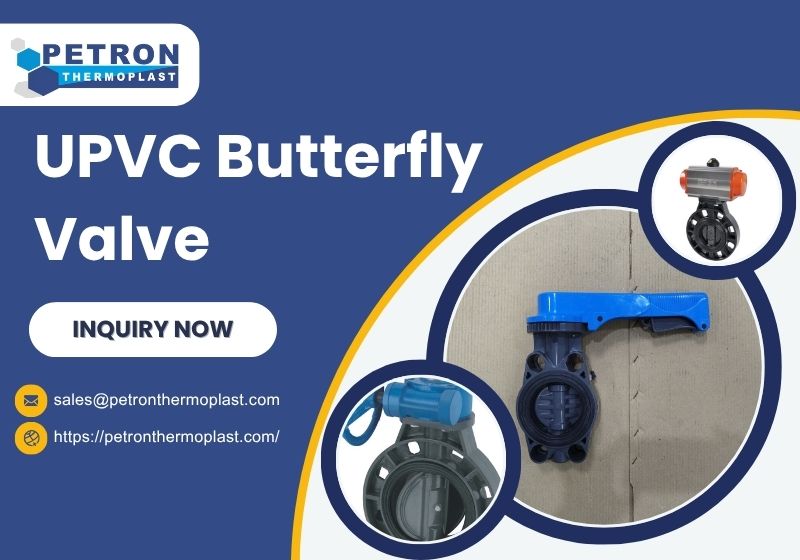UPVC Butterfly Valve – Improve Flow Control Efficiency
In modern industrial systems, precision, durability, and efficiency are essential for managing fluid flow. One of the most reliable and...

In modern industrial systems, precision, durability, and efficiency are essential for managing fluid flow. One of the most reliable and cost-effective components in this arena is the UPVC Butterfly Valve. Lightweight, corrosion-resistant, and easy to install, the UPVC butterfly valve has become the go-to choice for engineers looking to streamline operations while maintaining system integrity.
Whether you’re working in water treatment, chemical processing, or irrigation systems, a UPVC butterfly valve offers an exceptional balance of performance and affordability. In this article, we’ll explore how UPVC butterfly valves help improve flow control efficiency, reduce downtime, and contribute to better overall system performance.
What Is a UPVC Butterfly Valve?
A UPVC Butterfly Valve is a quarter-turn valve used to regulate or isolate fluid flow. It consists of a disc mounted on a rotating shaft within a circular body. Turning the handle or actuator rotates the disc to either block, partially open, or fully open the flow path.
Made from Unplasticized Polyvinyl Chloride (UPVC), these valves are specially designed for use in low-pressure and corrosive environments. UPVC offers excellent resistance to chemicals, UV rays, and corrosion, making it an ideal material for industrial fluid control systems.
Key Benefits of UPVC Butterfly Valves in Flow Control
- Enhanced Flow Efficiency
The design of a butterfly valve minimizes obstruction to flow. When fully open, the valve disc is parallel to the flow, resulting in minimal pressure drop. This contributes to more efficient pumping and energy savings in fluid systems.
- Precise Throttling Control
Unlike many on/off valves, UPVC butterfly valves allow for accurate throttling. The disc can be positioned at various angles to control flow rate effectively, making it ideal for applications requiring fine control.
- Fast Operation
Butterfly valves are quick to operate—just a quarter turn (90°) opens or closes the valve. This rapid operation reduces manual labor and is especially useful during emergency shutoffs or process adjustments.
- Low Torque Requirements
Thanks to the lightweight construction of both the valve and the UPVC material, butterfly valves require very little torque to operate, reducing actuator size and cost when automated.
- Corrosion Resistance
UPVC’s inherent resistance to chemical corrosion ensures that the valve remains functional and leak-free in applications involving acids, alkalis, and other aggressive media.
Common Applications of UPVC Butterfly Valves
UPVC butterfly valves are highly versatile and can be found across a wide range of industries, including:
- Water Treatment Plants – For isolating and regulating water flow in filtration, softening, and recycling systems.
- Chemical Processing – Safely handles acids, alkalis, and brine solutions.
- Irrigation Systems – Controls water distribution efficiently across agricultural fields.
- Food & Beverage Utilities – Used in non-food-contact utility lines such as washdown systems and CIP processes.
- Swimming Pools and Aquaculture – Offers reliable control in chlorinated and saltwater systems.
Technical Specifications and Features
| Feature | Details |
| Material | UPVC (Unplasticized Polyvinyl Chloride) |
| Disc Material | UPVC or Polypropylene |
| Seal Material | EPDM or FKM (Viton) |
| Pressure Rating | Up to 10 bar (145 psi) |
| Temperature Range | 0°C to 60°C (media dependent) |
| Operation | Manual, Electric, or Pneumatic Actuation |
| Size Range | DN50 (2″) to DN300 (12″) |
| End Connection | Wafer style, fits DIN/ANSI/BS flanges |
| Compliance | ISO 5211, ASTM D1784, DIN 8063 |
How UPVC Butterfly Valves Improve Flow Control Efficiency?
Let’s dive deeper into how these valves contribute to improving flow control efficiency in industrial operations.
- Optimized System Performance
The full-bore design of butterfly valves ensures a smooth, unobstructed flow of liquids, reducing turbulence and energy consumption. This allows pumps to operate at lower loads, enhancing the overall efficiency of the fluid system.
- Lower Maintenance Costs
Because UPVC is naturally corrosion-resistant, it eliminates the need for coatings or special maintenance routines required by metal valves. The lightweight design also minimizes wear on the pipeline supports and actuators.
- Reduced Installation Time
UPVC butterfly valves are easy to handle, align, and bolt between flanges. With no special tools or heavy lifting required, installation can be completed faster than with metallic alternatives, saving both time and labor costs.
- Extended Service Life
These valves are designed for long-term use even in chemically aggressive environments. When properly installed and operated within their pressure/temperature limits, they can serve for many years with minimal performance loss.
- Integration with Automation Systems
Modern industrial processes demand automation. UPVC butterfly valves are ISO 5211 compliant, allowing seamless integration with pneumatic or electric actuators for remote or automatic flow control. This makes them ideal for SCADA and PLC-based systems.
Choosing the Best UPVC Butterfly Valve
To maximize flow control efficiency, it’s crucial to select the right butterfly valve based on your system’s requirements. Here are some factors to consider:
- Chemical Compatibility – Ensure the valve’s body and seals are compatible with the fluid.
- Operating Pressure and Temperature – Select a valve rated for your system conditions.
- Valve Size and Flow Rate – Match the valve size to the pipeline and desired flow rate.
- Actuation Method – Choose manual or automated actuation based on operational needs.
Sustainability and Environmental Impact
UPVC butterfly valves are not just efficient—they’re also environmentally friendly. The manufacturing process of UPVC produces less greenhouse gas emissions compared to metal valves. Additionally, the reduced need for corrosion treatments and coatings makes them a more sustainable option in the long term.
Conclusion
In conclusion, the UPVC butterfly valve is a smart investment for industries looking to improve flow control efficiency while reducing operational costs. With benefits like chemical resistance, fast operation, energy savings, and easy integration into automated systems, it’s no surprise that UPVC butterfly valves are widely trusted across sectors. Whether you’re building a new fluid handling system or upgrading an existing one, choosing the best UPVC butterfly valve can make a significant difference in performance and reliability.




